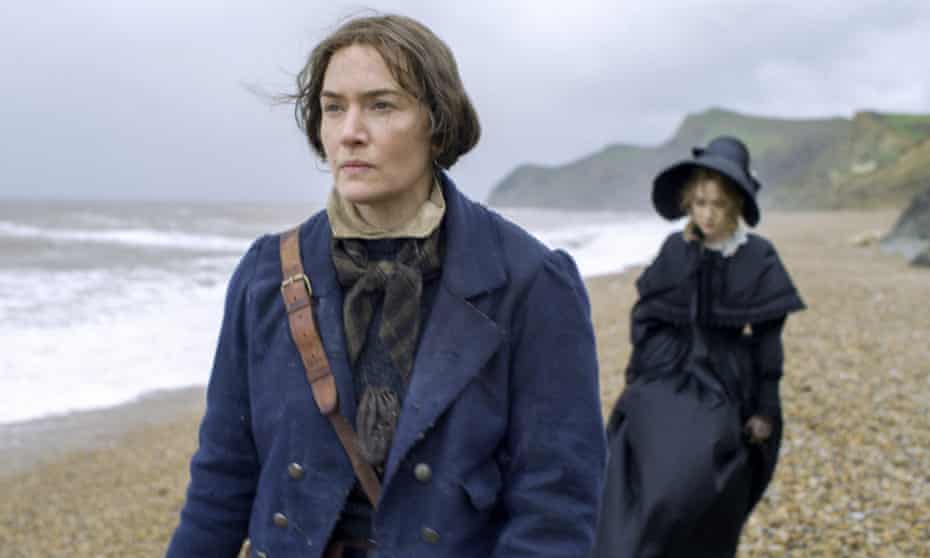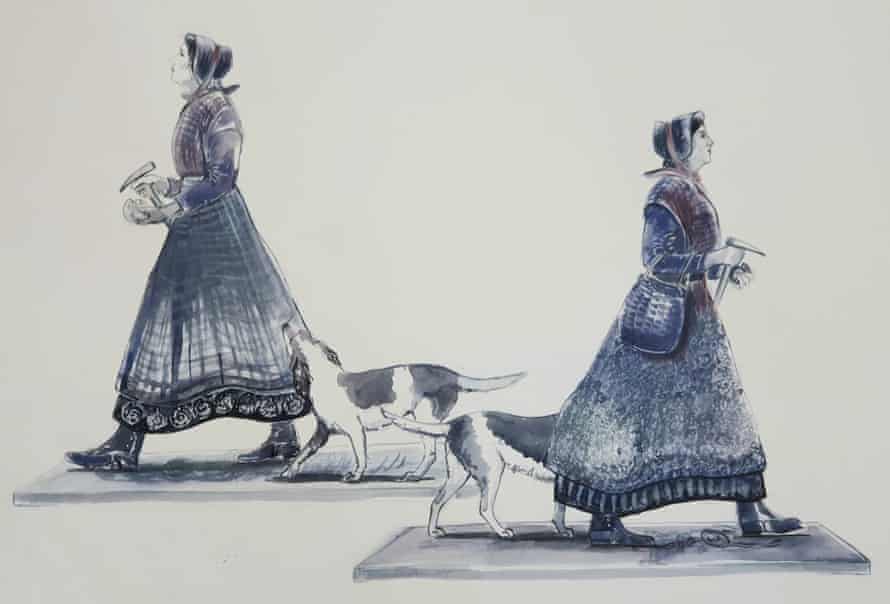A nine-year-old pointed out what was missing in Lyme Regis. Her long campaign has now borne fruit

Kate Winslet as Mary Anning in the film treatment of her life, Ammonite
Photograph: See-saw Films\bbc Films/Allstar
Esther Addley
Sat 21 May 2022
It all began with a curious nine-year-old and a question that she asked her mother. Where in their hometown of Lyme Regis was the statue of Mary Anning, the pioneering Victorian fossil hunter who, she had recently discovered, had lived and worked there?
There wasn’t one, Anya Pearson was forced to tell her indignant daughter. Anning’s lifetime of discoveries – including finding the first ichthyosaur skeleton at the age of just 12 – may have profoundly shaped the emerging science of palaeontology, but in her own Dorset town and farther afield, she had been largely forgotten.
The schoolgirl, Evie Swire, is now 15, and on Saturday she and Pearson will see that injustice finally righted, with the unveiling of a striking new statue of Anning, raised and funded thanks to a campaign they started as a direct result of Evie’s question.
Having overcome planning and Covid delays, been forced twice to find a new site and crowdfunded more than £150,000 through their Mary Anning Rocks campaign, the pair describe the moment as particularly sweet.
“I knew that one day it was going to happen, but obviously now that it’s finally here I’m very happy and very proud about it,” says Evie. Anning, she thinks, “would be very pleased that she was finally getting the recognition that she deserves”.
Anning was born in 1799 into a family that scratched its living, literally, from the coast around the emerging resort of Lyme Regis, digging fossils from the dangerously crumbling cliffs and selling them to collectors and museums. As well as the ichthyosaur, her finds include the first complete plesiosaur skeleton and the first pterosaur found in Britain.
But she was much more than a bone hunter, says the anthropologist and broadcaster Alice Roberts, a supporter of the statue campaign since the beginning.
“She wasn’t just a fossil collector, and this is really important. She understood what she was looking for, she engaged with the science of the time, although obviously [as a working-class woman] she couldn’t be a member of any of the learned societies of the time.”
While Anning certainly wasn’t given full credit for her expertise, notes Roberts, “it’s not as if she wasn’t well known in her time. Even though, in the 19th century and earlier, there were absolutely fewer women than men involved in science and writing about science, there were still plenty – and there are plenty we’ve forgotten.”
Esther Addley
Sat 21 May 2022
It all began with a curious nine-year-old and a question that she asked her mother. Where in their hometown of Lyme Regis was the statue of Mary Anning, the pioneering Victorian fossil hunter who, she had recently discovered, had lived and worked there?
There wasn’t one, Anya Pearson was forced to tell her indignant daughter. Anning’s lifetime of discoveries – including finding the first ichthyosaur skeleton at the age of just 12 – may have profoundly shaped the emerging science of palaeontology, but in her own Dorset town and farther afield, she had been largely forgotten.
The schoolgirl, Evie Swire, is now 15, and on Saturday she and Pearson will see that injustice finally righted, with the unveiling of a striking new statue of Anning, raised and funded thanks to a campaign they started as a direct result of Evie’s question.
Having overcome planning and Covid delays, been forced twice to find a new site and crowdfunded more than £150,000 through their Mary Anning Rocks campaign, the pair describe the moment as particularly sweet.
“I knew that one day it was going to happen, but obviously now that it’s finally here I’m very happy and very proud about it,” says Evie. Anning, she thinks, “would be very pleased that she was finally getting the recognition that she deserves”.
Anning was born in 1799 into a family that scratched its living, literally, from the coast around the emerging resort of Lyme Regis, digging fossils from the dangerously crumbling cliffs and selling them to collectors and museums. As well as the ichthyosaur, her finds include the first complete plesiosaur skeleton and the first pterosaur found in Britain.
But she was much more than a bone hunter, says the anthropologist and broadcaster Alice Roberts, a supporter of the statue campaign since the beginning.
“She wasn’t just a fossil collector, and this is really important. She understood what she was looking for, she engaged with the science of the time, although obviously [as a working-class woman] she couldn’t be a member of any of the learned societies of the time.”
While Anning certainly wasn’t given full credit for her expertise, notes Roberts, “it’s not as if she wasn’t well known in her time. Even though, in the 19th century and earlier, there were absolutely fewer women than men involved in science and writing about science, there were still plenty – and there are plenty we’ve forgotten.”

The design for the statue of Mary Anning.
Photograph: Mary Anning Statue Campaign/PA
That tide is beginning to turn, she feels, and for Mary Anning, that is certainly the case. In the past few years Anning has been added to the primary curriculum, and had a suite of rooms named after her at London’s Natural History Museum, where many of her finds are now kept. Ammonite, a film about her life starring Kate Winslet and Saoirse Ronan, was released in 2020.
“Kids now grow up knowing who she is; it’s just part of their educational DNA, so that’s brilliant,” says Pearson. “She is in really safe hands with the next generation.”
And it is not just Anning. “What is really lovely as well about the campaign is that it has shown us that there is a lot of love out there for historically forgotten women,” says Pearson. Others have been inspired to campaign to raise their own statues, with at least eight other projects currently under way under an umbrella group called VISIBLEwomenUK. “This is the end result of what happens when you put a load of women in a room together. We get shit done!”
For Roberts, who will unveil the statue, accompanied by her own 12-year-old daughter, “It’s so important for our girls to see these people and hear these stories. It’s important for our boys to hear those stories to and realise that, you know, the history of science is not exclusively male.”
That tide is beginning to turn, she feels, and for Mary Anning, that is certainly the case. In the past few years Anning has been added to the primary curriculum, and had a suite of rooms named after her at London’s Natural History Museum, where many of her finds are now kept. Ammonite, a film about her life starring Kate Winslet and Saoirse Ronan, was released in 2020.
“Kids now grow up knowing who she is; it’s just part of their educational DNA, so that’s brilliant,” says Pearson. “She is in really safe hands with the next generation.”
And it is not just Anning. “What is really lovely as well about the campaign is that it has shown us that there is a lot of love out there for historically forgotten women,” says Pearson. Others have been inspired to campaign to raise their own statues, with at least eight other projects currently under way under an umbrella group called VISIBLEwomenUK. “This is the end result of what happens when you put a load of women in a room together. We get shit done!”
For Roberts, who will unveil the statue, accompanied by her own 12-year-old daughter, “It’s so important for our girls to see these people and hear these stories. It’s important for our boys to hear those stories to and realise that, you know, the history of science is not exclusively male.”
No comments:
Post a Comment